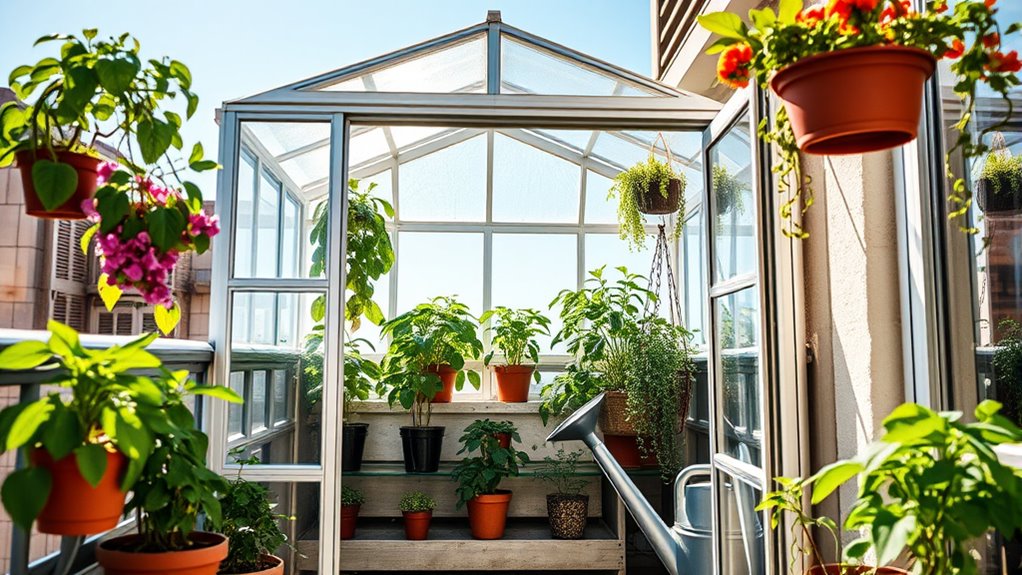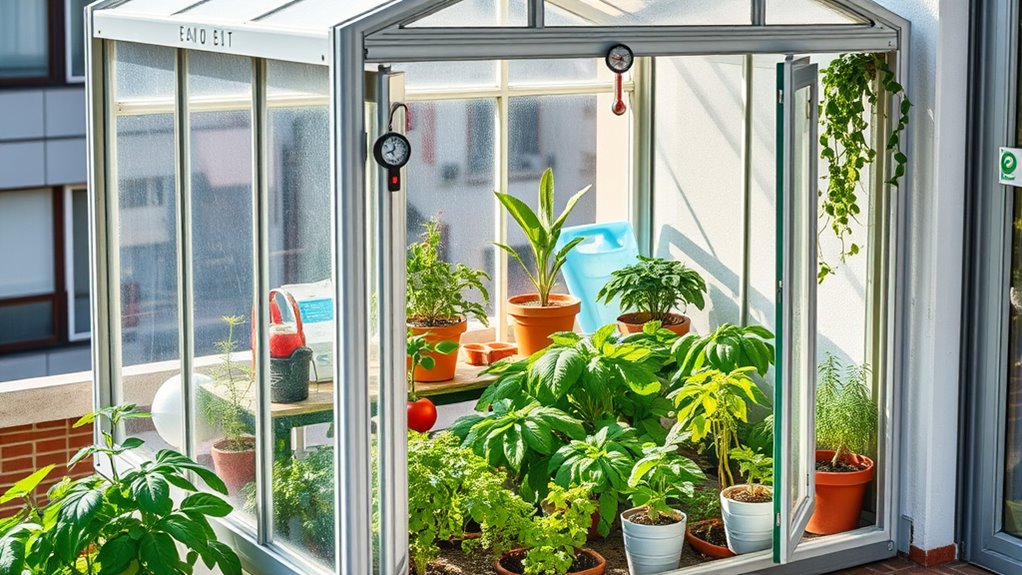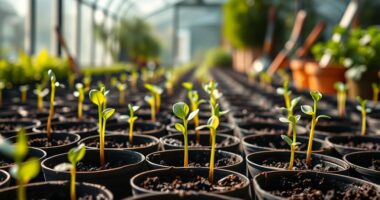With mini and portable greenhouses, you can maximize limited space by using vertical gardening, tiered layouts, and compact composting methods. Incorporate pest controls like beneficial insects and physical barriers, and consider mobility to optimize sunlight and protect plants from harsh weather. Maintaining healthy soil through efficient composting and companion planting keeps your environment thriving. Keep up with regular care, and you’ll discover ways to create a productive, sustainable garden even in small areas.
Key Takeaways
- Use vertical gardening and tiered setups to maximize limited space in mini and portable greenhouses.
- Incorporate compact composting methods like worm bins to recycle waste efficiently in small areas.
- Select pest control strategies such as beneficial insects and physical barriers suitable for confined spaces.
- Opt for lightweight, portable greenhouses to easily relocate plants and optimize sunlight exposure.
- Practice companion planting and regular maintenance to promote healthy growth in small greenhouse environments.

Greenhouse gardening is a fantastic way to grow fresh produce and vibrant flowers even if you have limited space. When working with a mini or portable greenhouse, maximizing your small area is essential, and understanding effective composting techniques can markedly improve your soil quality. Small-scale composting allows you to recycle kitchen scraps and garden waste efficiently, providing nutrient-rich compost that boosts plant growth without taking up much room. You can set up a compact compost bin or use worm composting (vermiculture) systems that fit neatly into tight spaces. This approach not only enriches your soil but also reduces waste, making your greenhouse more sustainable.
Maximize small greenhouse space with efficient composting and sustainable gardening techniques.
In a small greenhouse environment, pest control methods become vital to safeguarding your plants. Because space is limited, pests can quickly spread and cause damage, so it’s important to implement proactive strategies. Integrated pest management (IPM) is highly effective here, combining biological controls, such as introducing beneficial insects like ladybugs or predatory mites, with physical barriers like row covers or sticky traps. Regularly inspecting your plants helps you catch infestations early before they escalate. Maintaining cleanliness around your greenhouse also plays a key role—remove fallen leaves and debris that can harbor pests or diseases. Keep an eye on humidity levels; overly humid conditions attract pests and fungal issues, so proper ventilation is key.
Since your greenhouse is small and portable, mobility offers a noteworthy advantage, allowing you to relocate plants to optimize sunlight or protect them from adverse weather. This flexibility is especially useful when implementing pest control methods, as you can isolate affected plants or move healthy ones to safer areas. To further prevent pest problems, consider companion planting—growing certain plants together that naturally repel pests or attract beneficial insects. For example, marigolds can deter nematodes and aphids, helping you maintain a healthy, pest-free environment without resorting to chemical pesticides.
Balancing composting techniques with vigilant pest control creates a thriving environment inside your mini or portable greenhouse. The compact size demands that you be diligent about maintaining healthy soil and vigilant against pests, but it also offers the advantage of easier management. With consistent effort, you’ll produce lush plants, vibrant flowers, and bountiful harvests, all within a small, manageable space. Your ability to adapt and implement these methods makes small greenhouse gardening not only feasible but highly rewarding, even in limited areas.
Frequently Asked Questions
How Do I Choose the Best Mini Greenhouse for My Climate?
To choose the best mini greenhouse for your climate, consider its design and how well it adapts to your environment. Look for features like ventilation and insulation to handle temperature fluctuations. Select a model with climate adaptability, ensuring it maintains consistent conditions for your plants. Think about your local weather patterns and pick a greenhouse that offers durability and proper airflow, so your plants stay healthy year-round.
What Are the Maintenance Tips for Portable Greenhouses?
It’s often believed that regular maintenance isn’t essential, but investigating shows consistent care pays off. You should check your portable greenhouse regularly for damage, clean glass panels to maximize light, and adjust watering routines based on plant needs. Also, implement pest control strategies like removing debris and inspecting plants for pests. These steps keep your greenhouse in top condition, ensuring healthy plants and a productive gardening space.
Can Small Greenhouses Support Tropical Plants?
Yes, small greenhouses can support tropical plants if you manage their specific needs. To do this, you need to meet tropical plant requirements by controlling greenhouse temperature effectively, ensuring warmth and humidity are maintained. Use heaters, humidifiers, or shade as needed, and monitor conditions regularly. With proper temperature control, your compact greenhouse can thrive with tropical plants, creating an ideal environment despite limited space.
How Do I Prevent Pests in a Compact Greenhouse?
To prevent pests in your compact greenhouse, start with pest prevention by regularly inspecting plants and removing debris. Use pest barriers like fine mesh screens on vents and entry points to keep insects out. Keep humidity levels controlled and avoid overwatering, as pests thrive in damp conditions. Quarantine new plants before introducing them, and consider natural repellents like neem oil. These steps help maintain a healthy, pest-free environment for your plants.
Are There Eco-Friendly Options for Portable Greenhouse Materials?
Eco-friendly options for portable greenhouse materials include biodegradable plastics and recycled aluminum. While biodegradable plastics break down naturally, reducing landfill waste, recycled aluminum offers durability with less environmental impact. You can choose these sustainable materials to minimize your ecological footprint and promote greener gardening. Balancing innovation with conservation, these options help you nurture your plants responsibly, proving that eco-conscious choices can be both practical and sustainable in small-space gardening.
Conclusion
Think of your small space as a tiny island of green, where a mini or portable greenhouse becomes your ship. With a little effort, you can navigate the seas of limited space and harvest a lush, thriving garden. Don’t let size hold you back—your green oasis is just a little vessel waiting to set sail. Embrace these compact greenhouses, and watch your garden flourish, proving that even small islands can host mighty forests.









